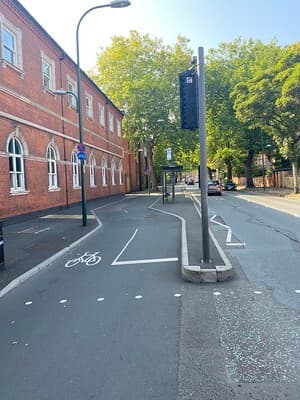
news: Reflecting on the DfT’s review of Inclusive Mobility and Tactile Paving Guidance
Monday 14th March 2022
A month ago, a long-awaited review of the Inclusive Mobility and Guidance on the use of Tactile Paving Surfaces was released by the Government. While the guidance did not introduce radically new design standards, it did place emphasis on areas previously overlooked, supporting development that is accessible to all. With technological changes continuing at pace, will the documents adequately address the changing situation in the future?
Government guidance on Inclusive Mobility was first published in 2005 and the tactile paving surfaces guidance was last revised in 2007. Both documents were updated in December 2021 to reflect current best practice and ensure that street design is equitable and inclusive. In the intervening 15 years between original publication and these updates, emphasis within the document has changed. By exploring these differences, we can understand not only changes in street design best practice, but changes in the transport industry and society as a whole.
Inclusive Design Principles
“Good, inclusive design benefits all users, including those who have non-visible disabilities." - Inclusive Mobility
Both updated documents make explicit references to Inclusive Design as a guiding principle within the creation of the guidance, explaining that disabled people need to be included in discussions from the outset as part of any infrastructure schemes. The importance of early engagement and consultation is stressed throughout both documents. Meanwhile, the new guidance places greater prominence on the social model of disability, with language updated to reflect this. While neither of these concepts are new, and many best practice examples already use these principles, the prominent inclusion of them provides a decisive step to ensure it is the norm within design moving forward.
Clarity & Direction
Within both updates, clarity and direction for best practice design has been improved. This is particularly the case for the Tactile Paving which provides concise guidance with well-labelled diagrams (see below). It emphasises that good street design is as important as tactile paving in supporting inclusive design. The guidance expressively states
“In particular, it is important that tactile paving surfaces are not used as a means of attempting to compensate for more basic flaws in street layouts.”
This emphasis on good design is continued in Inclusive Mobility, where the tone towards defensive street furniture, such as guardrails and bollards, is more reserved than in the previous iteration. This is welcome and reflects a stronger effort to embed the transport user hierarchy in scheme design to better support vulnerable road users through providing equitable solutions rather than protection.

In the intervening years between the iterations, multiple different policy and best practice guidance have been implemented. The Guidance Note LTN 1/20 on cycle infrastructure design (published in 2020), in particular, has led to foundational changes to both documents. Inclusive Mobility has a new chapter - ‘Making cycling facilities accessible to all’ - which considers the accessible design principles for infrastructure including cycle parking and signing. This emphasises the need to include cycle parking for accessible and adapted cycles in both long- and short-term parking locations. Meanwhile, both documents reflect best practice about the appropriateness of shared use routes in different contexts.
Next Steps
While Inclusive Mobility makes reference to technology (a new chapter is included – ‘The use of digital technology in public transport’), technology-related infrastructure has not been given detailed specifications.
An example is electric vehicle charging points (EVCPs). While EVCPs are addressed, the depiction is akin to a lighting column, rather than the same level of detail as other interactive street furniture such as pay-and-display machines. Yet more widely, concerns have been expressed regarding the hazards EV chargers can create and the limitations they can present to accessible design. Specific issues include trailing wires and decreased footway widths from on-street chargers, and the lack of disabled vehicle parking with charging facilities. As EVCPs become an ubiquitous part of our streetscape, guidance will be needed to ensure that these, too, are inclusive in their design.
EVCPs are just one example of how technology will inevitably change our streetscape, in potentially dramatic ways - and it is hard to concretely predict what the impact will be in 10- or 15-years’ time. Therefore, this guidance is likely to need to be updated more frequently if it is to consistently provide relevant best practice.
Overall, these revisions go a long way to better supporting inclusive design and provide a tangible tool for designers and planners. As a result, I hope that the updates are a catalyst for the following changes within the Transport Planning industry:
- Earlier and more continuous dialogue with a range of disabled people throughout the design process.
- More inclusive, less defensive street designs, which support vulnerable road users.
- Wider use of cycle parking infrastructure which provides space for accessible and adapted cycles.
ITP has helped to define and implement inclusive design standards for taxis, taxi ranks, bus and rail services, if you’d like to know more about our experience, please visit our Inclusive Mobility page or get in touch
